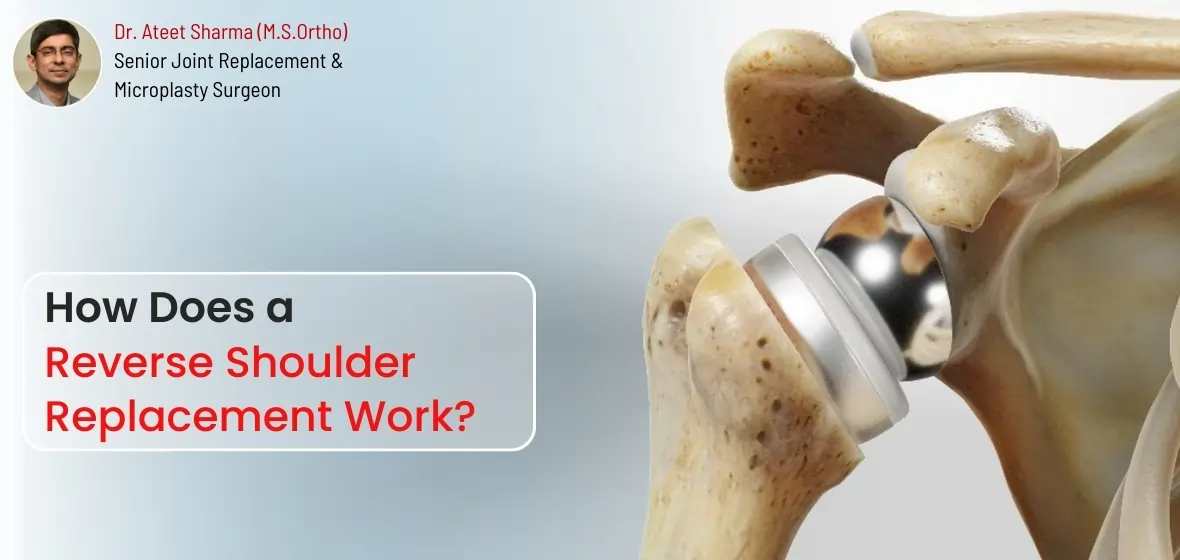
Imagine you hear your friend say that he needs a "Reverse Shoulder Replacement." But you have no idea what to say!
What does that even mean?
I am sure now you might be curious, so let us dive into this together and break it down in a way that you can explain to your friend the whole concept of how exactly a Reverse Shoulder Replacement works and reduce his nervousness. The process is performed in our clinic under the guidance of a specialist who ensures you get the best Shoulder Replacement Treatment in Ahmedabad.
Now Let Us Help You Understand Reverse Shoulder Replacement
Reverse Shoulder Replacement is a surgical process that allows a change of the position of the shoulder joint ball and socket; in simple words, the position of these two parts is reversed, which is why it is called Reverse Shoulder Replacement. If a person has an irreparable tear in the rotator cuff, then Reverse Shoulder Replacement is suggested.

If you have an issue with your shoulder, and for the same, you decide to visit a specialist. Firstly, medical history is checked, including any incident of any previous surgeries, chronic conditions, etc.
With the help of tools like X-rays, MRIs, and CT scans, a physical examination is done to check your general health. It helps in getting a clear picture of your shoulder structure.
After the completion of the physical examination, instruction regarding medication is prescribed, whether to stop or continue some medication, before the surgery takes place.
The guidelines regarding the eating and drinking part are also prescribed by the doctors beforehand if required.
Your body temperature, blood pressure, heart rate, and oxygen level are checked to analyse your fitness for further procedure.
The shoulder that is operated on will be marked, and anaesthesia is provided to make sure the phase of surgery goes painless. According to your situation, it is decided by the specialist whether to give general anaesthesia or regional.
The surgeon will make a cut at the front and top of your shoulder. This incision will allow the surgeon to have an excess to the shoulder joint.
Furthermore, deep cuts are done through the tissue to reach the shoulder joints. Now, this step is conducted by making sure that utmost precision is taken care of so that the damage is minimised.
After reaching deep, the humeral head (the top of the upper arm bone) is removed from its socket to create an excess for the surgeon to reach the joint surface.
If there is any small bony growth due to the development of arthritis, it is removed. The cleaning process is essential for the new components to fit in.
So, Now It's Finally Cleaned Up - Moving Further!
The upper arm bone is removed, as it is no longer needed once the new components are in place. The surgeon prepares for the upper arm bone to hold a new socket called the humeral cup. A metal stem is inserted into the bone to support the cup. The stem is used to maintain the stability of the new joints.
Now, the new parts are attached to the bones. By using bone cement, the surgeon tries to fit the parts quickly. It can done without bone cement. Here, the humeral cup is attached to the metal stem in the humerus and the glenosphere to the scapula. Finally, a new ball is placed into the new socket. The surgeon makes a clear analysis of the movement neatly. It involves rotating the arm in various directions to ensure the joint range of motion and stability.
After completing the above steps, the surgeon will stitch the incision back together, ensuring that the tissues align to the correct position. Once the recovery is over, you will be escorted to the recovery room to wake up from anaesthesia.
Our Ride Finally Comes To An End! But What Next? Is It Over?
No, the most important phase is that you recover nicely and get back to your routine as earlier. After the completion of the surgery, the doctor might suggest you rest in the hospital for a couple of days, depending on your condition.
Again, you still have to hear what the doctors have to instruct you to avail the most appropriate result.
The recovery from shoulder replacement will take time and patience. You will be advised to wear a sling to stabilise your shoulder and support healing. Over time, the progress will be evident because of exercise. It will eventually lead to strengthening the shoulder and improving its functioning. Our specialist, Dr. Ateet Sharma, will be there with you at each step to guide you to recovery. Having a trustworthy clinic support you is essential while making such decisions in life.
Now, it is time for you to get back to your friend and tell him you will be there with him at each stage, along with Dr Ateet Sharma. Support him by guiding him through the whole procedure of Reverse Shoulder Replacement. It makes him feel more confident, as an informed person will always have an ultimate spark of confidence in his eye.
© 2025 Dr.Ateet Sharma All rights reserved. | Manage by Nexus